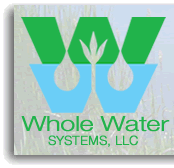Whole Water Systems for Eco-Resorts
Green as a prerequisite, no longer a Trend
"Green" is becomming a commonplace term used everywhere from the grocery store to the hardware store. Consumers are being given environmentally friendly options in more places than ever. The vacation and tourism industry is no exception. Travellers are demanding that their destinations be sustainable and "green" (the terms are interchangeable) and they're showing preference for those resorts which are environmentally friendly. LEED - the widely embraced green building standard by USBC - has fostered the demand for sustainable "green" Hotels that are LEED certified, giving attention to the materials used, waste managed in the building process, energy use, water use, and the health/comfort of the building among other things.
From a resort's perspective, being an legitimate "eco-resort" reaches much farther than simply slapping a couple solar panels on your roof and reducing the number of loads you put through your washer/dryer. The implications of "eco-resort" and "eco-tourism" reach into the effects that the resort have on the surrounding environment and ecology, the local socioeconomic impact, and the resources that are utilized. The latter (resources) is what we at Whole Water Systems are concerned with.
Whole Water Systems, Closing the Loop
At Whole Water Systems, we treat a conventional building/resort/home as a whole system. It is our goal to make that water system as close to a closed loop as possible. For Eco-Resorts, we offer a host of biomimicry solutions (CWB, VSB, RGB) for capturing/treating/and reusing water, all of which save money, save valuable resources, and offer you a competitive green marketing advantage at the same time.
CWB -
Constructed wetland Bioreactors
– tertiary treatment as attractive landscape amenities
RGB - Advanced Recirculating Gravel Biorectors
– high-performance biofiltration, maximum water reuse
VSB - Vertical Shaft Bioreactors
– high-flow solutions that use less land and energy, and make good neighbors
Good Solutions: Decentralized, Biofiltration
The good news for developers is that the truly sustainable solution – treating and reusing the water as close as possible to its source and point of use – brings with it significant benefits to a project.
Affordable, tertiary treatment to reuse standards
A truly decentralized approach removes the need for extensive collection. Since the sewer pipes represent the majority of the cost of the system, the savings can be significant. The EPA recognizes constructed wetlands as providing tertiary treatment to reuse standards so the more attractive solution can also provide high performance.
Scales well – single family / clusters / campus / municipal
Decentralized treatment can be tailored to the job at hand whether it’s for a single family residence, a cluster of buildings or a high-flow municipal scale application. This flexibility can provide tremendous advantages to land use planners and designers. By decoupling the need to facilitate sewer connections, designers and land planners have more choices with lot and building design.
Phases well – build as-you-go, lower up front infrastructure cost
Developers can hedge their financial risk by only building the wastewater and stormwater infrastructure they need – as they need it. With a decentralized approach, if only Phase 1 of a project has been built and is being sold, then only that phase’s water treatment costs have been incurred. And there isn’t any need to feed dog food to a large finicky central treatment plant that needs more occupants before it can function properly.
Landscape amenity – attractive, silent, odor-free
With good design, constructed wetlands can be an attractive asset to the landscaping. Because the water level is kept below the surface, the ground always remains dry and there is no odor and no possibility of breeding mosquitoes. Constructed wetlands can be designed with lush showy plants that invite gardening or with wetland grasses that can be mowed like surrounding turf. Because it is the plants that bring oxygen to the bacteria performing treatment under the surface, there is no need for a noisy blower to pump oxygen.
Little to no energy use
If topology allows, gravity can be used and no energy needs to be consumed for a constructed wetland to treat wastewater to tertiary standards and then to make beneficial reuse through a subsurface drip irrigation system. If the ground is flat, then a lift station is placed between the septic tank and the constructed wetland with a low energy sump pump that only operates long enough to move the intermittent flows.
Minimal maintenance and license / certification requirements
Similar to conventional septic systems, the primary maintenance of decentralized systems consists of monitoring the septic tanks and making sure that they are pumped on a regular basis. This can be easily managed by an HOA by setting up a maintenance contract with locally available pumping services. Unlike more complicated mechanical systems, constructed wetlands qualify for the EPA’s most basic level of operator certification – again, significantly reducing O&M costs.
|


